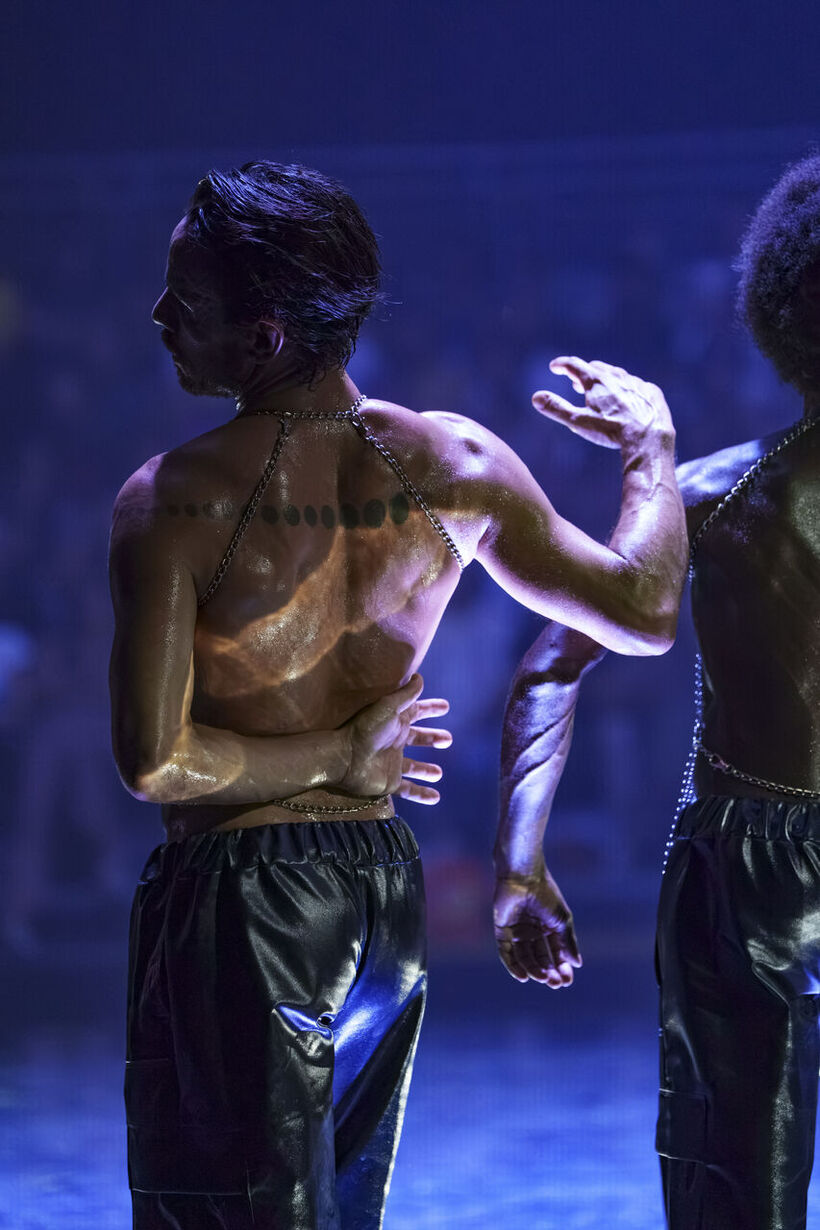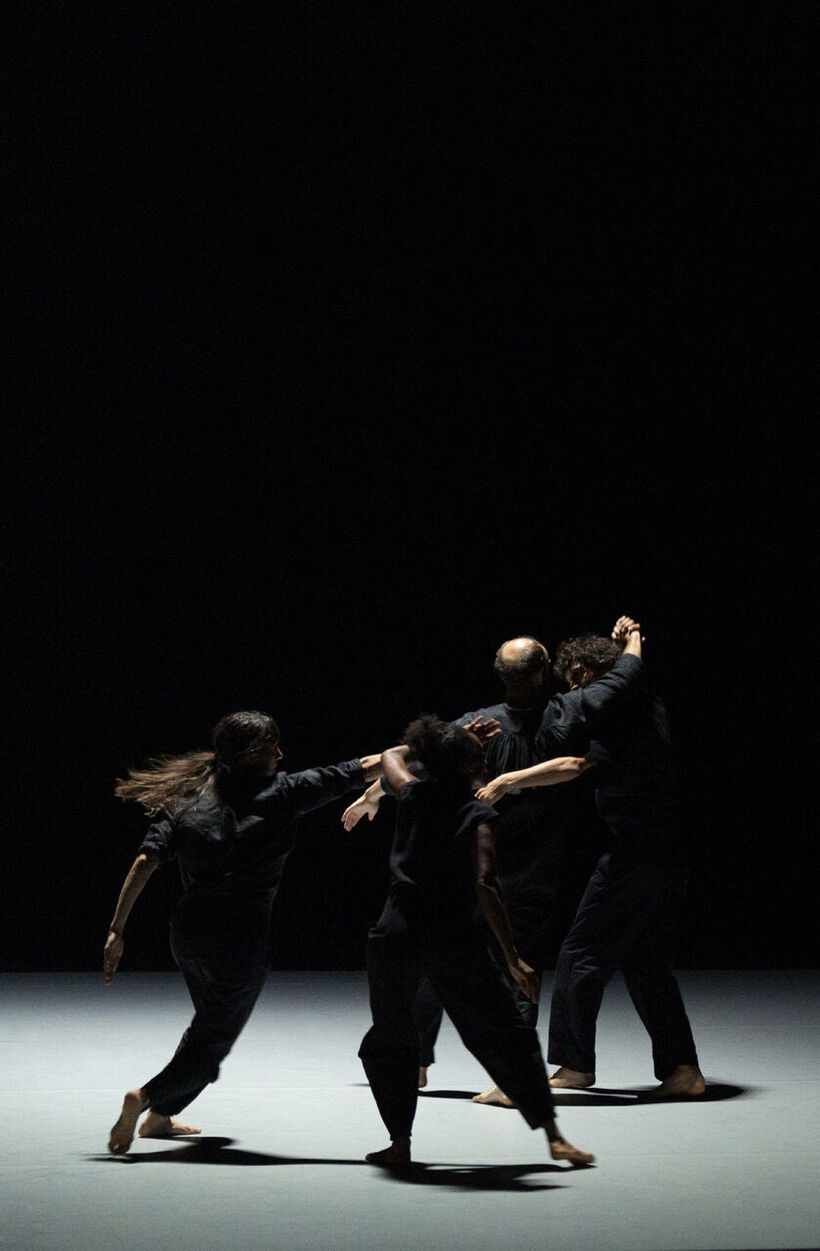This year’s theme, “Recycled dances”, promised to pair contemporary choreography with another style — be it clubbing, traditional dance, you name it. On paper, a generous idea: to build bridges, to cross-pollinate. In reality, the results were uneven. Costumes flirted with cultural appropriation or sheer kitsch. Bodies marched, endured, half-danced under the scorching sun. Admirable in their generosity, yes, but also emblematic of a form that has barely changed in forty years.
Dancing Together, Again and Again? Notes from the Biennale de la danse, Lyon 2025
The Défilé, or the Art of Recycling
Every two years, Lyon turns into an open-air stage. Here I am, standing on the pavement, squeezed between a giant balloon and a brass band that insists on being heard three blocks away, watching the inevitable Défilé de la Biennale. You are with me, in the crowd. Eyes squinting against the sun, dazzled by sequins, voices, chants, and smiles of the amateur dancers. It is noisy, chaotic, colourful, and yet strangely moving. There is energy in the air, the kind of energy that comes from the simplest of desires: to be together. That already feels like a small miracle.
Because the Défilé recycles not only its themes but also its structure: a parade of blocks, costumes, and slogans, like an endless procession of togetherness staged as endurance. It works, it gathers, it entertains. But what image of dance does it project? Togetherness in the form of colourful marching? Participation as cheerful labour? Some groups cracked open the mould: Aina Alegre’s queer retro-futurism, Tom Grand Mourcel’s focus on material coherence, but they remained exceptions. As the parade ended on the sunburnt concrete of Place Bellecour, with choreographer Mehdi Kerkouche shouting “Are you up for it, Lyon?!”, I could not help but wonder: is this what “being together” means for dance in 2025? Sweating collectively, shouting back, moving as one body under the summer heat?
It is already a lot. But is it enough?
Spectacles of the Collective: From Raves to Armies
If the Défilé plays at togetherness in the streets, the stage also kept returning to the collective. Take Gisèle Vienne’s Crowd. On entering the vast hangar of Les Grandes Locos, iron beams, holes in the floor, industrial scars, I felt the irony: a rave inside a warehouse, yes, but one that you access by car, like a supermarket. Vienne’s rave is in slow motion: hoodies, jeans, 1990s silhouettes caught in suspension, gestures stretched until time buckles. Moments are hypnotic, images arresting, but the collective fails to throb. Instead of sweat and friction, we get fragments and polite distances. What was once urgent in 2017 now reads as archaeological: the rave as relic. Still beautiful, but embalmed. The youth on stage looks borrowed from MTV reruns, not from the fractured, ironic, self-archiving dances of today.
Marco da Silva Ferreira, in F*cking Future, pushes in the opposite direction: excess, volume, unison. A queer army storms the stage, chests inflated, socks mauve, torsos aligned. Lasers, smoke, anthemic beats. It is a blockbuster, as generous as it is troubling. The slogans: “We do what we want” sound like advertising mantras, but the bodies say something else: urgency, resistance, a need to bind together. Watching, I stopped analysing; my body took over. I tapped, pulsed, and almost joined them. But then the question hit me: is this the future I want to applaud? A flamboyant, virile, disciplined queer army? The thrill was real, but so was the unease. Togetherness here felt less like multiplicity and more like uniformity, more regiment than rave.
So, two models of the collective: the rave turned relic, the army turned utopia. Both powerful, both flawed. Both circling the same question: when dance stages the collective, does it still generate genuine multiplicity or merely images of it?
Appropriations and Nostalgia
The Biennale’s title for 2025 could have been “Borrowed Gestures”. Aina Alegre’s Fugaces, her first creation as co-director of CCN Grenoble, invoked Carmen Amaya, the legendary bailaora who, in the 1930s, shattered flamenco codes, danced in trousers, claimed zapateado for women. A radical figure, of whom I confess I had never heard before. Discovering her story, I was stunned: such force, such modernity! On stage, however, that force trickled away. A ballroom-like circle of light, bare torsos, black gilets, percussive rhythms swelling into Boléro. Nostalgia coated as homage. And then the trombone moment: one performer suddenly becomes a musician, plays a melody, and exits once her contribution is “done”. A beautiful idea reduced to a dramaturgical checkmark. Carmen Amaya flickers in archival footage at the end: more alive, more modern, more radical than anything embodied live. So: a feminist piece? Perhaps in intention. But on stage, it felt like patrimonial respectability, not insurgent force.
Meanwhile, the Collectif A/R (Thomas Demay and Paul Changarnier) offered Dancing: immersive, inclusive, festive, with music (played live by Changarnier) so sumptuous it could have rescued any dramaturgy. The difficulty lay elsewhere. The dancers first gathered on the central platform, orbiting around the musician like satellites. Gradually, they expanded outward — moving through the peripheral scenographies and into the surrounding space, blurring, for a moment, the distinction between stage and audience. Yet despite this spatial fluidity, the supposed “immersive agora” often solidified into a frontal experience. The audience, initially invited to wander, found themselves orbiting instead — craning their necks, piecing together fragments of visibility between beams of light. Freedom, so generously promised, became a choreography of constraint. Freedom of what, and for whom?
Around this gravitational centre, a collage of styles: krump, house, contemporary, even khmer dance followed one another, but without real dialogue. The Cambodian form, detached from its histories, seemed more of an ornamental note rather than as part of an exchange. If not outright appropriation, it left at least the aftertaste of exoticisation.
The costumes, too, raised questions. A racialised performer dressed in pure white, a female dancer styled as “lolita”, others in grunge looks recalling the wardrobe of an eternal teenager, and finally a futuristic sparkle that felt two-thousand-and-late. The issue is not one of taste but of perspective: who authorised these images, and with what intention? Costumes do not merely cover bodies, they orient the way they are read. Here, instead of opening codes, they reinforced clichés with fluorescent emphasis.
So again: homage and collage, heritage and appropriation. One looks back, the other scavenges elsewhere. Both raise the same doubt: when we borrow, are we truly opening horizons or just recycling familiar images under the guise of novelty?
Voices, Resonances, Failures
Some of the most striking works dealt not with bodies alone but with voices. Idio Chichava’s Vagabundus began with sounds leaking from the hall: chants, shouts, laughter. By the time the audience entered, the space was overflowing. Thirteen performers, barefoot, in colourful shorts, carrying ropes, tyres, bags. Voices pierced, caressed, fractured. The music became unnecessary; voice was everything. Chichava, trained in Mozambique and at PARTS in Brussels, could have become another euro-centric choreographer. Instead, he has carved out something else: a global body, a dance of breath, weight, and resonance, drawing from Mozambican rituals without pigeonholing them as folklore. The piece oscillated between exuberance and melancholy, joy and resistance. And when the audience was invited to join in at the end: chanting, moving, merging, one could never mistake it for a staged participation. It was life, spilling over.
By contrast, Christian Rizzo (in À l’ombre d’un vaste détail, hors tempête) filled the stage with words, fragments of poetry by Célia Houdart, projected as subtitles: “flame”, “toy”, “grass”. The paradox was brutal: dance speaks, but here it was covered by captions, as if the bodies needed translation. Dancers in black, ghostly presences let gestures resonate: an arm still trembling from impact, a back folding under invisible weight. Fragile, fallible, haunting. But the resonance was suffocated by the words, by the sense that literature was hovering as a spectator louder than us. The piece ended in a funeral vigil, melancholic, beautifully staged. But again, to whom did it speak? To insiders who enjoy decoding the hidden messages of a piece? To an audience already fluent in the codes of subtlety? If the work mistrusts its own bodies enough to wrap them in subtitles, can it still claim to trust its audience?
Two visions of voice: one erupting from the chest and shaking the air (Vagabundus), the other plastered on the wall like a dictionary (Hors tempête). One generous, one suspicious. One that overflowed, one that closed in.
Images and Surfaces
Not all of the pieces engaged through discourse. Some leaned on image. Mercedes Dassy’s Spongebabe in L.A (4 Love & Anxiety), for instance, built a pop bunker of plush toys and glitter in which she sang divinely. Her voice was enough to hypnotise. But the body? Always posing, showing, exposing. A body-popstar, icon before interpreter. The milk-extraction scene (yes, she literally pumped breast milk on stage) could have been explosive if embedded in dramaturgy. Instead, it sat isolated, absorbed into the spectacle of “look what I dare to do”. The result was less collective confession, more solipsistic vitrine.
Miet Warlop’s INHALE DELIRIUM EXHALE chose not bodies but machines: giant textile rolls collapsing from the ceiling, unfurled and refurled in endless loops. Beautiful fabrics, yes. But dancers reduced to technicians, movers, handlers. A textile factory disguised as performance. Impressive? Certainly. Poetic? Perhaps. But what remains when movement is swallowed by machinery? A suspicion that the real choreography was economic: a production of images, heavy and costly, with little to say.
Both pieces revealed the same risk: when image overtakes body, the spectacle becomes surface. Seductive surfaces, ironic, well-lit, but hollow.
Hospitality, but for Whom?
In the midst of all this, the Biennale launched FORUM, a new platform for dialogue, curated around one keyword, “hospitality”. Indigenous artists from extra-European contexts were invited to present, share, and discuss. A rare gesture in France, where international curating often means “Europe plus a sprinkle of elsewhere”.
But hospitality is never innocent. It always defines a host and a guest. And here, the host remained the Biennale, with its timings, its formats, its professional audiences. Hospitality was offered, but on a clock, in a frame, on a stage that is already owned. The paradox was evident: we welcome you, but on our terms.
Another blind spot emerged: why speak of hospitality only towards distant others, while ignoring those within? How does the Biennale host artists from France’s own overseas territories, whose work remains marginalised on the national scene? Why is “hospitality” always projected outward, rather than applied inward, to reconfigure existing imbalances?
FORUM was not a failure. It opened cracks. It allowed rare presences to resonate. But it also risked becoming a showcase of diversity rather than a transformation of relations. In two years, we will see whether it goes deeper or whether “hospitality” remains a polite synonym for programmed exotism.
Beyond the Recycling
So what remains, after the parades, raves, armies, voices, and fabrics? The Biennale offered plenty: beauty, generosity, transcendence even, but also a nagging sense of déjà vu. Recycling became its dominant rhythm: the recycling of images, of appropriations, of codes long rehearsed. Togetherness staged like a marketing slogan. Hospitality turned into a curated window. Nostalgia disguised as homage.
The Défilé made the paradox plain: yes, it is moving towards sweating shoulder to shoulder with thousands of strangers, cheering for bodies that refuse to give up. That is already immense. But forty years on, is “immense” still enough if it repeats the same collective choreography of endurance, sunburn, and slogans?
The question is not whether dance can still gather us — it clearly can, but whether it dares to invent other ways of gathering. What if we stopped marching in circles and started reimagining the floor beneath our feet? What if hospitality meant not showcasing the Other but shifting the host itself? What if the collective were not a slogan, but a risk?
Perhaps the next step is not forward, but sideways — out of the parade, out of the script, into the unknown.
Written from the Lyon Dance Biennale from 6 to 28 September 2025
Gisèle Vienne - Crowd
Piece for 18 dancers – 2017
Concept, Choreography, Scenography and Dramaturgy: Gisèle Vienne
Assisted by: Anja Röttgerkamp and Nuria Guiu Sagarra
Music: Underground Resistance, KTL, Vapour Space, DJ Rolando, Drexciya, The Martian, Choice, Jeff Mills, Peter
Rehberg, Manuel Göttsching, Sun Electric, and Global Communication
Music Editing & Selection: Peter Rehberg and Gisèle Vienne
Sound Diffusion Design: Stephen O’Malley
Sound Technician: Adrien Michel
Lighting: Patrick Riou
Character Subtexts: The performers in collaboration with Dennis Cooper and Gisèle Vienne
Performers: Philip Berlin, Morgane Bonis, Marine Chesnais, Malick Cissé, Sylvain Decloitre, Sophie Demeyer, Vincent Dupuy, Massimo Fusco, Rehin Hollant, Oskar Landström, Maeva Lassere, Theo Livesey, Maya Masse, Nach, Katia Petrowick, Linn Ragnarsson, Jonathan Schatz & Henrietta Wallberg
Marco Da Silva Ferreira - F*cking Future
Piece for 8 dancers – 2025
Artistic Direction and Choreography: Marco da Silva Ferreira
Artistic and Dramaturgy Assistance: Catarina Miranda & Cristina Planas Leitão Performers: Catarina Casqueiro, Eríc Amorim dos Santos, Fábio Krayze, Doisy Bryan, Marco da Silva Ferreira, Matias Rocha Moura, Max Makowski, Nala Revlon
Performers (trainee): José Santos
Performers (residency): Mélanie Ferreira
Music: Rui Lima & Sérgio Martins
Light: Teresa Antunes & Rui Monteiro
Production Direction: Mafalda Bastos
Production Assistance: Ana Lopes
Production Structure: P-ulsa
Tour: ART HAPPENS
Aina Alegre’s - Fugaces
Piece for 7 dancers – 2025
Concept and Artistic Direction: Aina Alegre
Created and Performed by: Adèle Bonduelle, Maria Cofan, Cosima Grand, Hanna Hedman, Hugo Hagen, Yannick Hugron, Gwendal Raymond
Lighting Design: Jan Fedinger
Sound Design and Space: Vanessa Court
Costumes: Aina Alegre et Andrea Otin
Technical Coordination: Juliette Rudent Gili
Lighting Management: Roberto Baldinelli
Sound Management: Guillaume Olmet
Project Assistant: Séverine Bauvais
Artistic Support and Outside Eye: Juan Carlos Lérida and Marie Quiblier Acknowledgements: Montse Madridejos
Collectif A/R (Thomas Demay and Paul Changarnier) - Dancing
Piece for 5 dancers, 1 musician, and 1 lighting scenographer – 2025
Concept: COLLECTIF A/R X MODULE
Choreography: Thomas Demay
Music: Paul Changarnier
Artistic Direction: Paul Changarnier, Thomas Demay, and Julia Moncla
Performers: Thalia Apsor Provost, Ashley Biscette, Michaela Piklová, Joan Vercoutère, Karym Zoubert, and Paul Changarnier
Scenography: Nicolas Paolozzi - MODULE
Outside Eye: Julia Moncla
Costumes: Adélaïde Le Gras assisted by Charlotte Charton
Lighting: Nicolas Paolozzi - MODUL
Sound Management: Rémi Bourcereau
Idio Chichava - Vagabundus
Piece for 13 dancers – 2022
Company: Converge+
Concept and Choreography: Idio Chichava
Performers: Açucena Chemane, Arminda Teimezira, Calton Muholove, Cristina Matola, Fernando Machaieie, Judite Novela, Mauro Sigauque, Martins Tuvanji, Nilégio Cossa, Osvaldo Passirivo, Patrick Manuel Sitoe, Stela Matsombe, Vasco Sitoe Lighting Phayra Baloi Costumes: Idio Chichava
Christian Rizzo - À l’ombre d’un vaste détail, hors tempête
Piece for 7 dancers – 2025
Company: l’association fragile
Artistic Direction: Christian Rizzo
Performers: Enzo Blond, Fanny Didelot, Hans Peter Diop Ibaghino, Nathan Freyermuth, Paul Girard, Hanna Hedman, Anna Vanneau (in progress)
Lighting Design: Caty Olive
Original Music: Pénélope Michel and Nicolas Devos (Cercueil / Puce Moment)
Text: Celia Houdart
Stage Managers: Jérôme Masson / Victor Fernandes
Sound Technician: Delphine Foussat
Lighting Technicians: Clément Huard / Romain Portolan
Mercedes Dassy - Spongebabe in L.A (4 Love & Anxiety)
Piece for 1 dancer – 2024
Concept, Choreography, Performance, Lyrics: Mercedes Dassy
Dramaturgy: Hanna El Fakir
Music Production and Sound Design: Maxime Pichon
Scenography, Costumes, Props: Flavie Torsiello assisted by Emma Paris, Marie-Céline Debande, Lyv Santerre
Lighting Design: Vera Martíns
Stage Manager: Lila Ramos
Lighting Technicians: Vera Martins, Charlotte Müller
Sound Technicians: Lucie Gresil, Maxime Pichon
Makeup Artist: Melissa Roussaux
Outside Eyes: Svétäl-Anand Chassol, Alphonse Eklou, Sabine Cmelniski
Assistanat: Fanny Brulé Kopp
Harmonisation of Extract of Virginie Despentes’ Speech: Chassol Stagiaires Morgane Brien-Hamdane, Géraldine Tatard, Angelica Ardiot, Robin Dehenain
Miet Warlop’s INHALE DELIRIUM EXHALE
Piece for 7 dancers and musicians – 2025
Concept, Scenography, and Direction Miet Warlop
Music: in collaboration with DEEWEE
Performers: Milan Schudel, Emiel Vandenberghe, Margarida Ramalhete, Lara Chedraoui, Mattis Clement, Elias Demuynck and others tbc
Scenography: Miet Warlop in collaboration with Mattis Clement
Costume Design: Miet Warlop in collaboration with Elias Demuynck supervised by Tom Van der Borght
Lighting Design: Henri Emmanuel Doublier
Lighting: Pieter Kinoli
Sound: Ditten Lerooij
Assistant Director: Marius Lefever
Production Manager: Sylvie Svanberg
Technical Coordination: Marjolein Demey
Director: Saskia Liénard
Outside Eyes: Giacomo Bisordi, Danai Anesiadou





.jpg)
